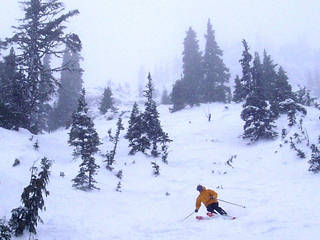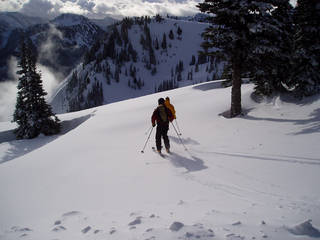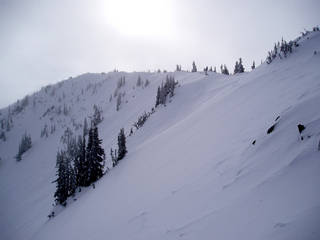Crystal Mountain, WA – Virtually unknown to skiers outside the state of Washington, Crystal Mountain is a local’s ski area with world class terrain and copious amounts of snow. With more than 2,300 acres spanning 3,100 vertical feet in-bounds (2,612 feet lift-served), and an avalanche controlled backcountry more than doubling it’s acreage, Crystal Mountain ranks with the ski resorts of Colorado, Utah and Jackson Hole. Average annual snowfall is around 350 inches, surpassing most of the Colorado resorts and right up there with Jackson Hole and many of the Utah and British Columbia ski resorts.
So, then, why don’t people know about it, you ask?
|
Crystal Mountain steeps. |
It’s simply because there are not enough amenities at the resort to attract families for ski vacations, not to mention the higher water content snow and possibility of rain. There are four places to stay at the resort that are simple and basic and lack hot tubs, health spas, boutiques or even a vending machine. There’s not much else to do when the lifts stop turning at Crystal. The crowd moves down to the Snorting Elk Pub when the Bull Wheel bar at the base lodge closes. When the bartender decides it’s time to close, which seems to be before midnight or when beer sales drop, whichever comes first, then everyone goes home and goes to bed.
Seattle is less than two hours away, so this mountain rules as a local Seattle-Tacoma ski area. Weekends are jammed with local season pass holders. They turn people away on some weekends once the parking lots fill keeping the slopes uncrowded, though the high-speed six pack chairlifts do keep people on the snow longer with very short waits in line.
To the mountain
From Seattle, it is an easy 75-mile drive towards Mount Rainier. Hang a left before the Mt. Rainier National Forest toll booths and up the hill to Crystal Mountain. Just 13 miles from Rainier, Crystal Mountain sports excellent views of the sleeping 14,408-foot volcano. A grey veil of thick clouds shields this view for much of the winter. We didn’t even get a glimpse of the sun during our visit, and most Seattleites will tell you that it is rare to see much sunshine in the winter. The up-side of those grey clouds is snow at the right elevation. The base elevation of Crystal is just over 4,400 feet and the highest lift ascends to almost 7,000 feet.
The snow
Some snow fell at the base area during our visit, followed by pouring rain. The snow line fluctuated between 4,000 and 5,000 feet throughout the day. A quick lift ride would carry you out of the rain into a zone of heavy, wet flakes blowing sideways and splattering on your goggles. We attempted to ski in the blinding wet snow and wind. The upper mountain was on wind-hold, so we were limited to the lower mountain during our first day. We could only go as high as the top of the Forest Queen Express six-pack at just over 6,000 feet. It was snowing heavily at that elevation and the first turns off the lift and into the woods were getting deep.
We stuck to the trees and worked our way through the thickening cement as we descended the mountain with each turn. The resort was kind enough to reduce its usual price, since three of Crystal’s ten lifts that access the upper mountain were closed. Since it was a weekday it was fairly quiet, with only a few hearty souls tackling the weather and the heavy, wet and sticky snow conditions. The weather was tough going. It was a Gore-tex day and those without good waterproof ski wear were not happy or simply not skiing. The Gore-tex gloves on my hands became heavy like wet sponges and began to leak through the seams. The Pacific Northwest weather really tested our wet weather gear.
After a morning of blinding wind, snow and rain it was time to peel off the soaked layers, hang them up to dry over the radiator in our room at the Alpine Inn, and put the boots on the boot dryers while taking a long lunch break at the Snorting Elk Pub. There is a deli adjacent to the pub, so soup and a sandwich brought into the pub could be washed down with a local microbrew. This lodge can be skied to if you ski north of the main base lodge (skier’s left) past the Miner’s Basin lift. You can pretty much ski right to the door, poke your skis in the snow and come in and dry off by the fireplace while ski porn radiates on the large screen across the pub.
With gear nearly dry we hoped to make more fresh tracks in the newly fallen snow late in the afternoon. The snow line was again above the base lodge, but once past tower 7 on the Chinook Express, we were in Snowville again. The top of the Forest Queen held fresh deep snow, but still so thick that it required a lot of effort to ski.
The air seemed to get cooler as the afternoon progressed and the snow at mid-mountain was drying out. We ended early in hopes of resting up for what was shaping up to be a super powder day on the upper mountain in the morning.
Big powder day
The early morning snow report called for all lifts running and 13 inches of fresh snow. The upper mountain had accumulated snow the previous 24 hours without any skier traffic, so we knew that it was going to be good up there. This was the day to explore the mountain for the first time and to ski fresh snow all morning long.
|
Frank Martinez and Wayne Grevey ski a first run on Sunny Side. |
About 100 people lined up at the Chinook Express 15 minutes before the lifts opened, chomping at the bit for first tracks in fresh snow. Thirteen hundred acres of fresh snow awaited. The lift line quickly disappeared as the high-speed six-pack lift carried skiers up the mountain to spread out on the trails and lifts above. I noticed a plethora of skiers on extra fat sticks, including the K2 Pontoons donned by professional skier Wayne Grevey who shared his home mountain with us. There is something to be said for a fat ski on a powder day, and a fat ski floated nicely on the deep powder at the top of the mountain while making some of the thicker and heavier snow towards the lower parts of the mountain much more manageable. It would have been much more difficult to cover as much terrain as we did in variable deep snow conditions back in the old days of skinny skis.
Grevey suggested we start our day on Sunny Side. At the top of the Chinook Express we headed right and skied over to the Rainier Express to find some fresh snow in the morning sunshine. Wind had blown the snow off of some faces and onto others, so our morning turned into a search for the deepest windblown snow.
On a second ride up the Rainier Express we exited left and traversed over to Bear Pitts, with nice views of the Silver Queen. Supposedly at the top of the Rainier Express and the High Campbell lifts are spectacular views of Mt Rainier, but sadly these views were enshrouded in clouds throughout the day. We enjoyed fresh deep snow in the Bear Pitts.
|
The Throne. |
A ride up the High Campbell double sets the skier up for a number of good options, including an out-of-bounds traverse and boot pack up to the top of The Throne for excellent opportunities for fresh snow on steep chutes. There are also many gates that will take you to the backcountry, but that is another story for another day.
Backcountry North and South
There are 1,300 acres of avalanche controlled backcountry skiing accessible from various points along Crystal Mountain’s upper ridges. The North Backcountry is accessed via the top of the Snorting Elk bowl by turning right when exiting the Green Valley lift and proceeding to skier’s far left. This area will get its own chairlift in time for this winter, the new Northway lift, which will make returning to the ski area from the North Backcountry much easier. The new Doppelmayr fixed-grip quad will span nearly a mile with a 1,870-foot vertical rise. Prior to this season the run would drop you down to the road where you would have to walk or hitchhike back up. Local die-hards will now have to work to find fresh turns in the North Country without competition.
The South Backcountry is accessed via a traverse and boot pack beyond The Throne. We were able to boot pack up to the summit of The Throne, but the South Backcountry that lies beyond was closed for avalanche control during our visit. A steep run down The Throne gave us a taste of what a short boot pack can yield at this wonderful mountain.
A full morning of powder sampling made our group hungry and ready for a short rest. The new Campbell Basin Lodge was right in our range.
|
Crystal Mountain’s spectacular Campbell Basin Lodge. |
The Campbell Basin Lodge is a spectacular mid-mountain refuge that opened in December 2004. With over 12,500 square feet of elbow room, this beautiful edifice is a Northwest Cascade heavy timber and stone design with 24-inch hand-peeled Douglas fir logs with laminated trusses, beams and exposed tongue and groove vaulted ceilings. Truly remarkable craftsmanship went into the making of this huge lodge. Large windows reveal beautiful views of the Silver King, The Throne and the Campbell Basin.
Gourmet-style cafeteria food, with the typical food stations found in the newer lodges at the more upscale ski resorts throughout the country is what you’ll find here. This wasn’t a budget lunch, but the choices were many and quality was high.
Good to go
After a quick bite we headed back out in hopes of finding some remaining fresh powder. What we found instead was a lot of tracked powder that turned into a lot of work as the afternoon wore on. We were wearing out as we took our last run off the Green Valley lift through the Snorting Elk bowl down to Kelly Gap Road, the escape route down the mountain at the end of a good long powder day. With legs like spaghetti we wound our way down the mountain and skied right back to our digs at the Alpine Inn.
Lodging
As already mentioned, lodging options are very limited at Crystal Mountain itself. There are three buildings operated by Crystal Mountain Hotels and a privately owned property of condos and timeshares.
The Alpine Inn is a Bavarian Style ski lodge that is basic, yet clean and comfortable. It has a real European feel that resonates inside and out. On the hallway walls are historic photos of the region. Take a few minutes and really check these photos out, as they will take you back in time. The rooms are small, simple and clean. The rooms lack phone or TV, but there’s a fireplace and payphone in the lobby.
In the basement of the Alpine Inn is a ski locker room with a ski shop. If you need to rent high-performance skis or a tune this would be the place. The guys who work there are very friendly and helped us out when we needed different wax to get by on the sticky snow. Conveniently, you can ski right to the door of the ski locker room.
The Quicksilver Lodge and the Village Inn are more contemporary hotel-style accommodations, and some rooms feature lofts to accommodate families. Unlike the Alpine Inn, the rooms have TV/VCR for après ski entertainment. There is no food on premise at these properties, so for dinner head to the Bull Wheel Restaurant at the Base Lodge or cut across the parking lot and cross the bridge to the Alpine Inn where you’ll find an upscale restaurant upstairs or the Snorting Elk Deli adjacent to the pub downstairs.
After food and drink are consumed there is nothing to do but read a book by the fireplace in the front lobby or rest up for another day of skiing. If you are a late night person, and need entertainment, you can borrow a book from the shelves in the lobby. Be sure you get your dinner before the restaurants close. There are no late-night munchies to be had for miles. Not even a vending machine.
Where the Locals Go
Since Crystal Mountain doesn’t seem to have much of an après ski scene outside of the Snorting Elk Pub, we were wondering where the local ski bums live and what bars they frequent. After all, with a mountain of that size and caliber, there must be a local community. We didn’t find it until we drove down the road at the end of our visit.
As we approached the small town of Greenwater (population near 100 year-round residents) we noticed some activity. A ski shop, a clothing store/coffee shop and a bar serve this small settlement. Thirsty from two days of skiing Cascade powder we pulled right into the Naches Tavern. Walking past the empty pool tables and around patrons slumped over beers at the bar, we found a table in the back near the fireplace. After placing our order the sofa in front of the fire urged us to migrate to it and relax in the glow of the burning logs. You can buy a raw hot dog for $3 and cook it yourself over the fire. It seems that this is where the locals go, and many ski area employees live in or near Greenwater or Enumclaw, the next closest town that has a decent population and the businesses to serve it.
So why go to the Pacific Northwest
The ski areas of the Pacific Northwest have some serious terrain and copious amounts of snow. The snow isn’t the champagne dry variety, but it is skiable and there is plenty of it on terrain that is very interesting and challenging. Accessible backcountry makes the Cascade ski areas extremely appealing. This trip was the perfect antidote to a snowless early winter in the east.




